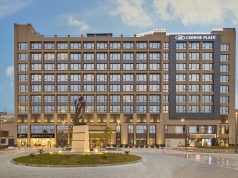We caught up with Ahmed Hayman after he came back from the excitement-fuelled second edition of the Gouna Film Festival, to ask him about his intimate celebrity portraits photo shoot that featured many of the big names who attended the festival. Hayman shared his experience and inspirations that have carried him through his career.
How did you get to be a part of GFF?
We managed to approach the team behind GFF four months before the festival and we suggested the idea of the photo shoot, which they liked and gave us a small studio in TU Berlin in Gouna.
What was the inspiration behind this photo session?
We were thinking about how festivals around the world like the Oscars, Toronto, Sundance, or Cannes all have a studio away from all the lights of the red carpet. The studio is designed for some intimate shots with celebrities, so we decided to do something similar here in Egypt.
How do you get natural reactions from the actors/actresses knowing that they’re being photographed?
All the emotions behind these photos are real and aren’t being acted out by the celebrities, they came as a result of some questions that we asked or in some cases the music we played. Surprisingly, all the celebrities were very flexible and welcoming to this technique.
What is it like working with celebrities?
I’ve worked with all kinds of people doing street and travel photography. I’ve also been to 25 different countries around the world, so when it came to celebrities, it wasn’t a hard job at all. They were all cool and very relaxed during the session, some of them even mentioned that they felt as if they were doing a form of therapy.

Who was your favorite celebrity during the shoot or who did you have fun shooting the most?
I had fun shooting all of them actually, so I have no favorites. I even enjoyed taking shots of Abla Fahita since we were already old friends.
What started your passion for photography?
Before I started expressing myself through writing, photography was my only way of sharing my thoughts and opinion. It all started in 2003 when I had just received a small digital camera from my family, and I started taking lots of photos. I was especially interested in humanity, people, culture, and traditions. I did a lot of projects involving street photography and old people; I also used to take photos of people who were released from the mental hospital.
What made you shift your photography style from crime and natural disasters to celebrities and portraits?
I worked for a crime newspaper Akhbar El Hawadeth during university. At that time I was photographing crime, courts and police stations and it was really difficult, but I learned a lot about how to deal with people, how to anticipate their reactions and behavior, and how to “feel” everything happening around me. Later on, I started working with Al-Masry Al-Youm, and was doing all kinds of photography like travel, portrait, landscape, and sports. I even traveled with the national team to the world cup qualifications 2008, so I did a bit of everything. After trying out lots of styles of photography, I found portrait and travel projects to be my favorite.
How did you start Beit El Sura?
I met Reem Osama, currently my wife, five years ago. She’s an applied arts graduate and she loves filmmaking, visuals and photography, so we decided to start Beit El Sura as a project together two years ago. Beit El Sura is a photography school, a group of professional instructors including myself give basics and advanced classes and workshops for all types of photography like portrait, travel, food, and fashion. It’s also a gallery and a photography studio for people to rent and shoot their projects.
What’s the inspiration behind the photos that you take?
I traveled to Denmark in 2011 to study visual storytelling at the Danish School of Media and Journalism; was a huge jump in my career. I learned a lot from the experience, like how to control my emotions, how to convey them to other people, how to create and tell a visual story – it was truly a life-changing experience. I traveled to Denmark 2 days before the revolution here in Egypt, so I had to go back to document it, and I kept going back and forth between Denmark and Egypt completing many projects here and there – it was pretty historical!
Moreover, observing people is one of my biggest inspirations. I sometimes take the metro or walk around in the streets, and I just observe people and try to guess their reactions. I’m really inspired by human behavior.
What else do you do other than photography?
I keep reading, experiencing and learning more every day through teaching photography. My old boss and godfather Hossam Diab always told me that when you share your knowledge, you empty space for more knowledge to enter. I really enjoy teaching, giving workshops and talks. I feel even happier and more proud when I see results from the people I teach. For me, their work is a sign that I did a good job.
Find more about Ahmed Hayman through his Facebook or the official website





